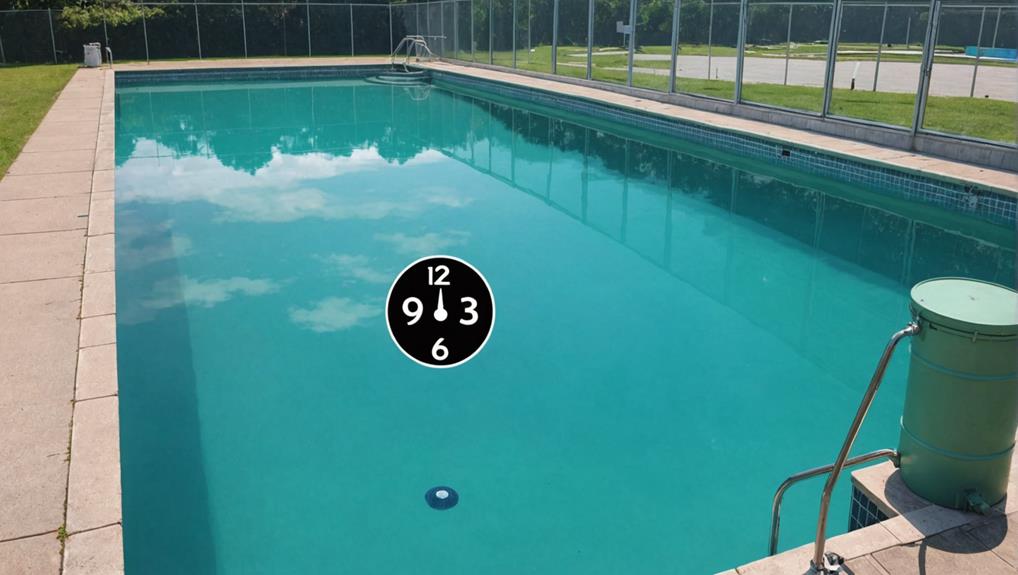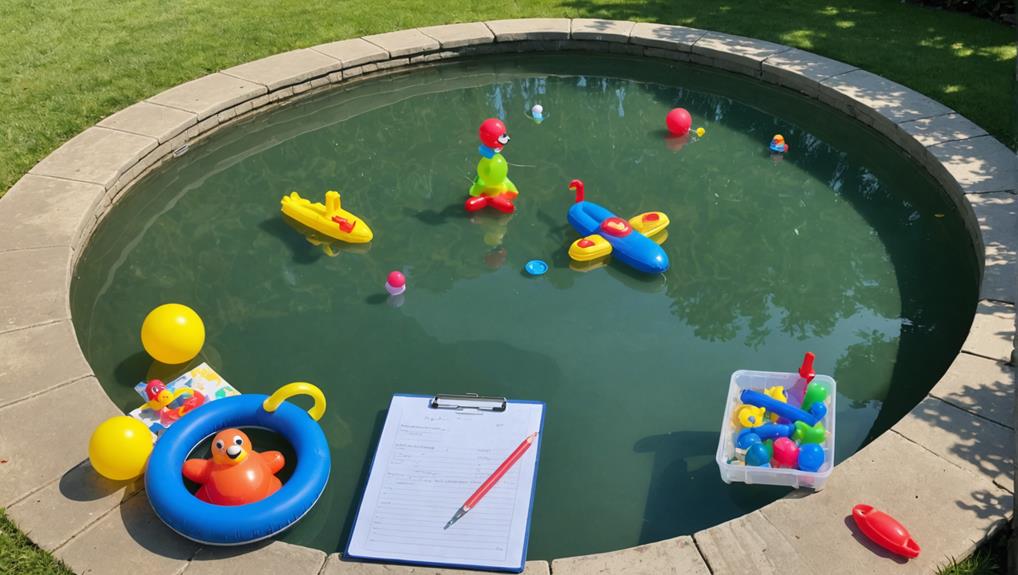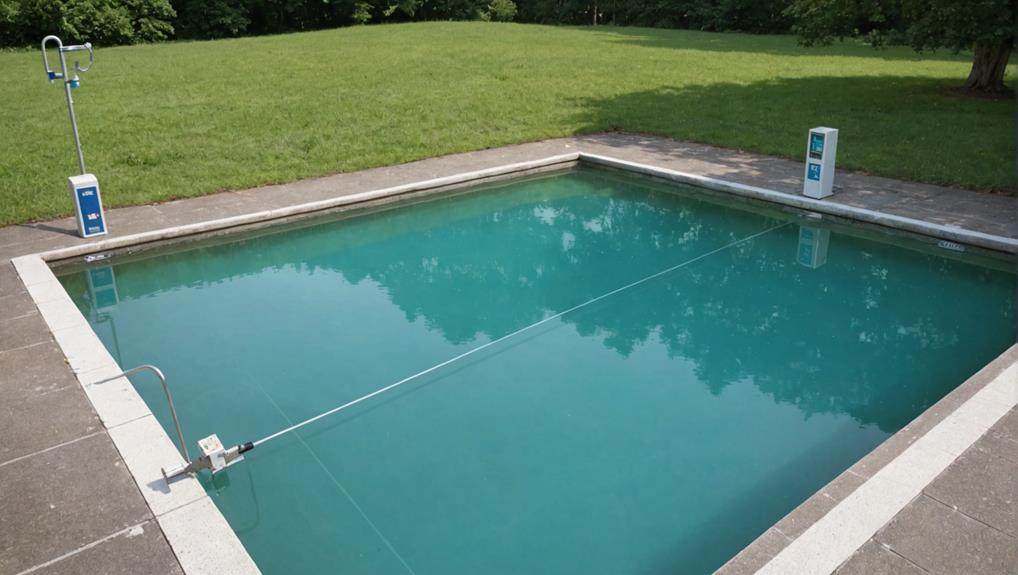You’re likely making one of the five common mistakes that can throw your pool’s chemical balance off kilter. Inadequate pH level adjustments can lead to eye and skin irritation, while ignoring calcium hardness levels can cause damage to pool surfaces and equipment. Improper shock treatment timing can ruin your water quality, and inconsistent chlorine level maintenance can allow bacteria to thrive. Failing to test your water regularly can lead to a host of problems. By recognizing these mistakes, you’re already taking the first step towards a safer, healthier pool environment – and there’s more to learn about how to get it just right.
Key Takeaways
- Failing to regularly adjust pH levels can lead to eye and skin irritation, corrosion, and compromised pool safety and appearance.
- Neglecting to monitor and adjust calcium hardness levels can cause damage to pool surfaces, equipment, and accessories.
- Improper shock treatment timing can lead to poor water quality, pH imbalances, and damage to pool equipment.
- Inconsistent chlorine level maintenance can lead to ineffective sanitizing, allowing bacteria and other microorganisms to thrive.
- Failing to test water regularly can lead to unbalanced pH levels, causing eye irritation, skin rashes, and damage to pool equipment.
Inadequate Ph Level Adjustments
Failing to regularly adjust your pool’s pH levels can lead to a cascade of problems, from eye and skin irritation to corrosion of equipment and surfaces, ultimately compromising the safety and appearance of your pool.
If you don’t keep your pH levels in check, you’ll risk reducing the effectiveness of your sanitizers, making it difficult to maintain a safe and healthy pool environment.
Inadequate pH level adjustments can also cause cloudy or murky water, making it challenging to detect underlying issues or maintain a clean pool appearance.
Additionally, pH levels that are too high or too low can lead to scaling or etching on your pool surface, resulting in costly repairs or replacement.
To avoid these issues, regular testing of your water’s pH and alkalinity levels is vital.
Ignoring Calcium Hardness Levels
When you neglect to monitor and adjust your pool’s calcium hardness levels, you’re risking damage to the pool surface, equipment, and accessories, as well as compromising the overall safety and appearance of your pool.
Calcium hardness levels should be maintained between 200-400 parts per million (ppm) to prevent scaling, corrosion, and damage to pool equipment and surfaces.
Ignoring calcium hardness levels can lead to etching on concrete, fiberglass, or vinyl pool surfaces, resulting in costly repairs and refinishing.
Low calcium hardness levels can cause water to become aggressive, dissolving the grout and mortar between tiles, while high levels can lead to scaling and clogged filters.
Regular testing of calcium hardness levels is vital to maintaining a balanced and safe pool environment.
Failure to test and adjust calcium hardness levels regularly can result in an imbalance that affects the efficacy of other pool chemicals, such as chlorine and pH balancers.
Improper Shock Treatment Timing

You risk undermining the effectiveness of shock treatment and compromising your pool’s water chemistry if you don’t time it correctly. Improper shock treatment timing can lead to poor water quality, pH imbalances, and even damage to your pool or its equipment.
Three key considerations to keep in mind when timing your shock treatment:
- Avoid shocking during the day: Sunlight can burn off 1-2 ppm of chlorine per hour, reducing its sanitizing effectiveness. Shocking at night allows the chlorine to work more efficiently, providing better sanitizing results and reducing the risk of algae growth.
- Don’t shock too frequently: Over-shocking can cause a buildup of calcium hardness, leading to cloudy water, scaling, and damage to the pool’s plaster or liner. Make sure to test your pool water’s free chlorine level before shocking and only shock as needed.
- Wait before adding other chemicals: Not waiting the recommended 24-48 hours after shocking the pool before adding other chemicals can cause unpredictable reactions and further imbalance in the pool’s water chemistry. By timing your shock treatment correctly, you can maintain a safe and healthy swimming environment.
Inconsistent Chlorine Level Maintenance
Maintaining a consistent chlorine level between 1 and 3 parts per million (ppm) is essential, as it directly impacts the sanitizing effectiveness and overall health of your pool’s water.
You must avoid inconsistent chlorine level maintenance, as it can lead to ineffective sanitizing, allowing bacteria and other microorganisms to thrive in the pool water.
Failing to test chlorine levels daily can result in under-chlorination, causing eye irritation, respiratory problems, and other health issues in swimmers.
On the other hand, over-chlorination can cause skin and hair damage, as well as damage to the pool and its equipment.
To maintain a consistent chlorine level, you should shock your pool on a regular basis, such as once a week, to remove built-up contaminants.
Additionally, testing chlorine levels at least twice a week and making adjustments as needed will guarantee a safe and healthy swimming environment.
What are the most common mistakes people make when trying to achieve chemical balance in their pools?
Many people struggle to achieve chemical balance in pools by making common mistakes such as adding too much chlorine or not testing the water regularly. Failing to properly balance the pH and alkalinity levels can also lead to cloudy or green water. It’s essential to follow proper guidelines for maintaining achieve chemical balance pools.
Failing to Test Water Regularly

Two critical tests – pH and alkalinity – are overlooked far too often, leaving your pool water vulnerable to a cascade of problems.
Failing to test your pool water regularly can lead to unbalanced pH levels, causing eye irritation, skin rashes, and even damage to your pool’s equipment.
To avoid these issues, you should test your pool water at least twice a week, using test strips to monitor pH, Total Alkalinity, and calcium hardness levels.
Three essential testing habits to adopt:
Check pH levels daily: Verify your pool’s pH is balanced between 7.2 and 7.8 to prevent sudden changes that can affect the efficiency of your chemical feeder and automatic chlorinator.
Monitor Total Alkalinity: Maintain a Total Alkalinity level between 80 and 120 ppm to stabilize your pool’s pH and prevent sudden fluctuations.
Test calcium hardness regularly: Guarantee calcium hardness levels are within the recommended range (200-400 ppm) to prevent scaling and etching of your pool’s surfaces.
Frequently Asked Questions
In What Order Should I Balance My Pool Chemicals?
When balancing your pool chemicals, you should follow a specific sequence: adjust total alkalinity, then pH levels, followed by calcium hardness, stabilizer addition, and finally, chlorine levels, to maintain proper chemical sequencing and ideal water balance.
How Do You Fix a Chemical Imbalance in a Pool?
You fix a chemical imbalance in a pool by using a test kit to identify water quality issues, adjusting pH levels, considering shock treatment to prevent algae growth, and ensuring proper filter cleaning, stabilizer levels, free chlorine, total alkalinity, and calcium hardness.
What Chemical Can Ruin a Pool?
You’ll ruin your pool with improper use of chlorine, bromine, or sanitizers, causing calcium buildup, copper corrosion, algae blooms, pH shock, or stabilizer malfunction, while an oxidizer excess or cyanuric error can lead to sanitizer failure.
What Pool Chemicals Should Not Be Added at the Same Time?
When adding chemicals to your pool, you shouldn’t mix Shock Chlorine with Algaecide, as it causes pH Interference, or combine Stabilizer with Oxidizer, which triggers Sanitizer Reactions, and avoid mixing Clarifier with Flocculant or Bromine Blends, which can lead to Calcium Overload.
Conclusion
By sidestepping these common missteps, you’ll be well on your way to achieving a harmonious balance of pool chemicals.
Remember, a delicate dance of pH, calcium hardness, and chlorine levels is essential to maintaining a safe and sparkling oasis.
Failing to test regularly can lead to a perfect storm of problems, but with vigilance and attention to detail, you’ll be able to orchestrate a symphony of sanitation and enjoyment.

I’m Max, the founder and chief pool enthusiast behind Pool Pro Tips. As a passionate pool owner and cleaning expert, I created this website to share my knowledge and experience with you, helping you to keep your pool sparkling clean and safe for years to come.

